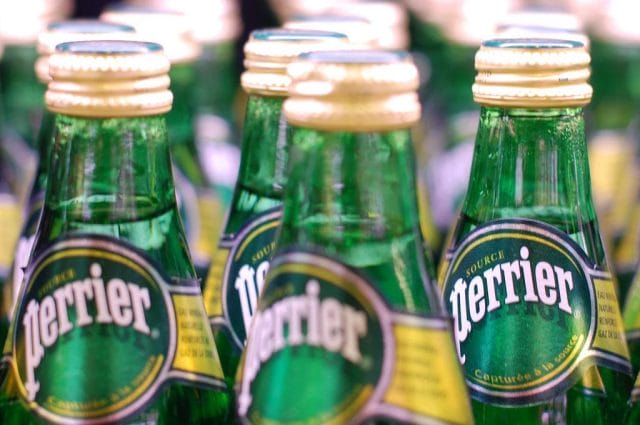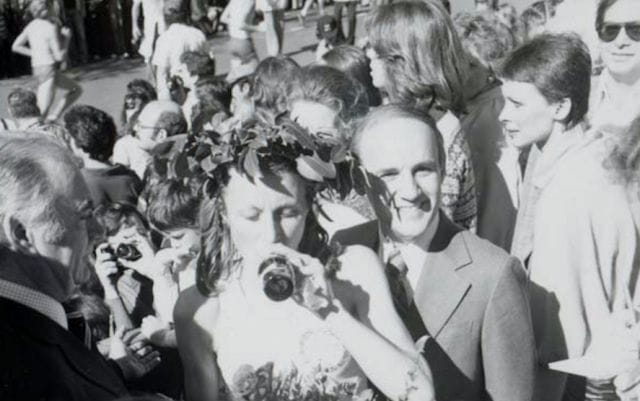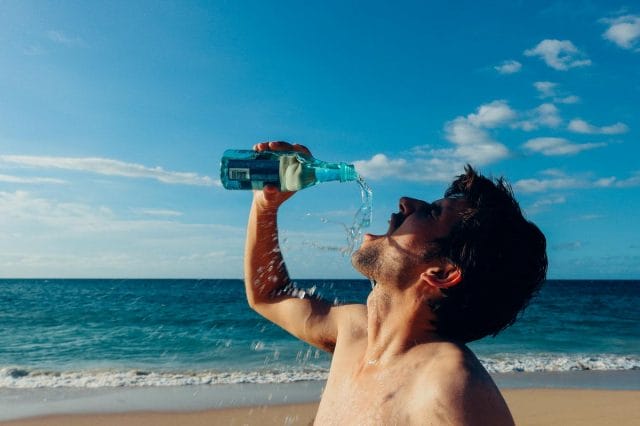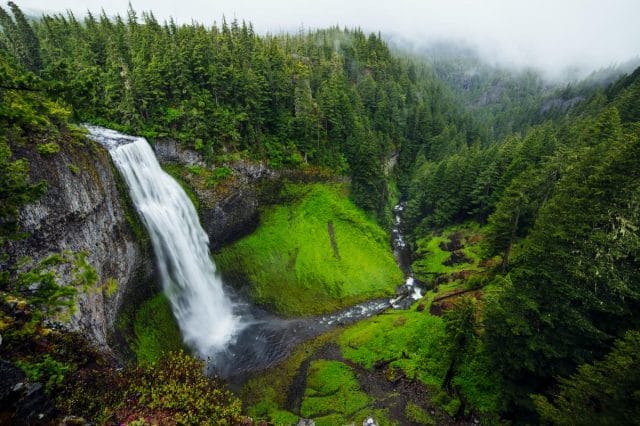Even if they could afford it, many people would balk at the thought of paying $10,000 for a sandwich. And yet the majority of Americans pay a similar markup, essentially, for a bottle of water.
Americans weren’t always so open-minded about opening their wallets for H20. Mere decades ago, they would have laughed at paying astronomical markups for a liquid that flows freely, and usually safely, from their taps at home.
That all began to change in the 1970s, with a crazy idea from a Frenchman who wanted Americans to buy fizzy water in green glass bottles shaped like bowling pins.
His company was Perrier, and its carefully constructed, impeccably timed advertisements paved the way for one of the greatest feats (or scams, depending on whom you ask) in marketing history.
Perrier’s campaign created a massive new market for the American beverage industry, and it still serves as a playbook for how to convince people to pay for water. At the same time, it does not fully account for what remains an even greater mystery: the enduring appeal of bottled water.
Whether they choose fizzy Perrier, flat Poland Spring, or a different label, Americans are guzzling more bottled water than ever before. And in an era defined by speed and convenience, they show no signs of slowing down.
“Earth’s First Soft Drink”
Gustave Leven had an idea: Convince Americans that they wanted to drink Perrier.
The chairman of Source Perrier, Leven had purchased the languishing French company in 1947, after he “concluded that if the [local] people of Vergeze could sell a natural mineral water for three times the price of wine, then the company must have remarkable potential,” according to a company history.
“It was a well-known name with no sales,” Leven later said in explaining his decision.
For the first three decades of the 1900s, Perrier supplied Buckingham Palace with “the champagne of waters.” After its founder, British entrepreneur St. John Harmsworth, died in 1933, and later, with the onset of World War II, production all but collapsed.
Under Leven, it again began to flourish. Thanks to mass advertising, sales grew fifteen-fold between 1946 and 1952, from 10 million bottles to 150 million. By the mid-1970s, Perrier was the top sparkling water in France.
Soon, Leven set his sights across the Atlantic. In the United States, elite restaurants and hotels in New York and Los Angeles were already selling Perrier. But Leven wanted more.

Photo credit: Maurizio Pesce
In 1976, Perrier opened an office in New York. Leven shared his scheme with hard-charging American marketing executive Bruce Nevins, who had recently left Levi Strauss. In those early days, Leven’s vision for Perrier had more skeptics than believers.
The hindrance seemed obvious: Who would pay for water when they could get it for free? At the time, the only water people bought came primarily in the form of jugs delivered to homes and offices for use in coolers.
Perrier would not change this paradigm, many predicted. McKinsey, for one, carried out a study concluding that the sparkling French water did not have a viable future in the United States.
Even Nevins needed some time to believe that Americans could be persuaded to pay for fancy water. But once he came around to the idea, he rolled out a campaign that would change Perrier — and water in America — forever.
Perrier’s American transformation began with television ads in the spring of 1977. They were straightforward, but ear-catching and eye-catching. The company spent an estimated $2.5 million to $5 million on the campaign. (That’s roughly $9.8 million to $19.7 million in today’s dollars. For comparison, in 2001, as PepsiCo and Coca-Cola began competing for market share, they spent $14 million and more than $20 million to promote Aquafina and Dasani, respectively.)
“More quenching, more refreshing, and a mixer par excellence,” intoned the rich baritone of Orson Welles in a Perrier advertisement dated 1979, as a bubbling stream cascaded from a green bottle and swirled into a clear goblet.
“Naturally sparkling, from the center of the earth,” the actor continued. He wrapped up the ad with a single word, the “r”’s perfectly French: “Perrier.”
Perrier’s advertising was selling a specific message, and it targeted a specific population: well-to-do baby boomers, born between 1945 and 1965, as they entered adulthood. It sought to assure them that those who partook of Perrier’s sparkling waters were sophisticated, classy, and conscientious. It conferred, in a word, status.
“It was a sophisticated way to go to a cocktail party and not drink alcohol,” says Gary Hemphill, the director of research at the Beverage Marketing Corporation. Unlike soda, Perrier wasn’t sweetened. It was the non-alcoholic, fizzy drink for adults.
The price of the water reflected that clout. Nevins lowered the price of a 23-ounce bottle from $1.09 ($4.30 today) to 69 cents ($2.72 in 2016 dollars) — within the reach of a certain strata of society, but significant enough that buying it still constituted a statement. It rested in that sweet spot of being simultaneously aspirational and accessible.
“It fairly sparkles with snobby cachet,” People magazine declared of Perrier in 1978.
As Leven said in 1990, he spent 40 years building the company “around an image of perfection.”
Parcourses and Marathons
Perrier also needed its messaging to reach the right ears. So the company found ways to prominently link its name with fitness. Given the running boom of the late 1970s — The Complete Book of Running was a bestseller in 1977 — capturing the attention of a growing contingent of health aficionados (or wannabes) was a shrewd move.
In November 1977, a few months after its TV ads began preaching the gospel of sparkling mineral water, Perrier sponsored the New York City Marathon. The race, then in its seventh year, was rapidly gaining traction.
Entries in 1977 more than doubled from 1976, the same year that the marathon’s course was freed from the confines of Central Park and expanded to the far more visible streets of New York. In 1977, when 4,823 runners paraded through the five boroughs, Perrier provided shorts and shirts bearing its logo.
The overarching message was clear: For people who cared about their bodies, who wanted a natural refreshment that departed from the cheap flavors of their time, Perrier was the obvious choice.
“If people are looking for the kind of flavor blast they’ve been conditioned to from age 1 — in baby foods, presweetened cereals and soft drinks — they’re not going to find it in Perrier,” Nevins told People the following year.

Grete Waitz drinks bottled water after winning the 1978 New York City Marathon. Photo credit: New York City Parks
Perrier sponsored other marathons and shorter races, too, including a 10k jointly with Bloomingdale’s in April 1978. Perrier also financed some 200 Parcourses — fitness trails with exercise equipment stationed along the way — throughout the U.S., including one at Stanford University (where Nevins had earned his MBA).
When Stanford’s new Parcourse opened in October 1980, it kicked off with an inaugural “Run, Hop, Leap and Jump” competition.
“Winners will receive Perrier-Parcourse t-shifts [sic],” the Stanford Daily reported. “And the refreshments? Perrier, of course.”
In the end, Perrier’s introduction to America was a smashing success. In 1975, Americans bought 2.5 million bottles of Perrier. By 1978, the company was predicting sales upwards of 75 million bottles that year alone. Over the next decade, sales continued to spurt, approaching 300 million bottles annually.
The name Perrier became synonymous with sparkling water, the way one might ask for a Kleenex instead of a tissue.
A Tsunami of Bottled Waters
Perrier was not the only beverage company bolstered by its pioneering ad campaign. Its success also inspired a slew of brands to compete for shelf space.
Within a few years of Perrier’s campaign, so many companies were trying to sell their own versions of fizzy water that stores in New York City appeared to be “drowning in a sea of carbonated waters,” noted the New York Times in April 1983.
Seagram’s and Schweppes, both American companies, aimed to persuade budget-conscious shoppers to select its seltzer water — carbonated tap water. Another French company, Evian, marketed its water, a flat variety drawn from springs in the French Alps, the same way Perrier had: by tapping into the health and wellness trend. One ad featured suggestive shots and sounds of sweaty men and women (they were merely working out) who replenished themselves with Evian.
Perrier “planted the seed in the minds of consumers that, ‘Hey, water can be a refreshment beverage,’” says Hemphill, of the Beverage Marketing Corporation. “Sometimes consumers don’t know what they want until it’s offered to them.”
In 1978, Americans bought 500 million gallons of bottled water. Over the next decade, it nearly quadrupled, to 1.8 billion gallons. Perrier, which had since acquired U.S. brands like Arrowhead and Poland Spring, dominated both the domestic and imported markets.
The next year, Perrier inadvertently set the stage for yet another watershed moment.
In February 1990, random testing uncovered traces of benzene in samples of Perrier in the U.S., forcing the company to carry out a four-month, nationwide recall. Its share of the imported mineral water market dried up from nearly 45 percent before the contamination to barely more than 20 percent a year after.
For other beverage companies, the disaster was an opportunity. A few years later, as Perrier was recovering (Nestle acquired it in 1992), PepsiCo made its move.
In its research, the company had noticed how customers would buy a bottle of spring water, like Perrier, finish it, then refill it at the tap. That last step sparked a minor revelation: Maybe the value of bottled water did not disappear along with its contents. Maybe, the vessel itself was worth something.
As a soda maker and distributor, PepsiCo already had the infrastructure to purify and sell tap water. In 1994, it spent $3 million to install additional equipment, for reverse osmosis, at a plant in Wichita, Kansas. It introduced Aquafina there, before rolling it out nationwide three years later.
Not to be outdone, Coca-Cola came out with Dasani in April 1999. It, too, came from municipal sources, not springs like Perrier and Evian.
Soon, the two beverage behemoths were engaged in a fierce battle for bottled water customers, especially as Americans began to drink less soda and sales started to decline.
“Water is not a carbonated soft drink,” Robin Kaminsky, who at the time was Pepsi’s director of alternative beverages, told the Wall Street Journal in 2002. “It’s very different and very special.”
In June 2001, PepsiCo launched a series of five television ads emphasizing Aquafina’s purity. The spots featured water pouring from a bottle, streams and droplets swishing and dancing through the air. The actress Lisa Kudrow, of Friends renown, did the voiceovers. “Aquafina promises nothing,” she said. “Pure nothing. Go ahead. Take a sip.”
Coca-Cola took a different tack. It promoted Dasani by linking it — this should sound familiar — with health. It placed ads in health and fitness magazines and even hired a team of wellness specialists, the Wall Street Journal reported that year.
Bottled tap water quickly gained on spring water, skyrocketing from 3 percent of the market in 1993 to 36 percent 10 years later. By 2013, purified tap water constituted more than half of the bottled water market.
Overall, bottled water is poised to eclipse what has long been America’s most popular drink: By the end of this year or early next, the Beverage Marketing Corporation projects, Americans will drink more bottled water than soda.

Data by the Beverage Marketing Corporation; chart by Priceonomics
The Eternal Quest for a Fountain of Youth
Skillful as the marketing was, it does not fully account for why Americans were, and still are, paying for a product they can get for free. (Taste does not explain it; tests have shown that people can’t tell the difference between tap and bottled.)
One factor is lifestyle. Today, the “number one driver” of bottled water sales is convenience, says Jim Salzman, the author of Drinking Water: A History. To grab and go is the 21st-century way. Bottled soda is convenient, too, but in an ever more health-conscious society, water is winning out.
The other explanation for bottled water’s lasting appeal is more unconscious.
As long ago as the fourth century, holy waters were seen as having healing powers both physical and spiritual, as Salzman recounted in his book. In the 18th century, people bathed in non-blessed waters like the springs of Contrexéville, France, or Saratoga, New York, hoping they would dissolve kidney stones, fix digestive problems or alleviate a rash of other ailments.
Today, the curative promise and possibilities of water still entice people. Most of us have likely heard that proper hydration boosts our energy or brain function, or improves our skin, or that water flushes away fat and aids in weight loss.
Companies selling water justify, fuel, and capitalize on those hopes. The tagline for Evian, which promises naturally filtered waters with “the purity, mineral content, and taste that nature intended,” says it all: “Live young.”
Bottled water endures because no one is advertising the idea that tap water has the same power to hydrate and nourish. Instead, disasters such as lead contamination in Flint, Michigan, erode public confidence in the water supply. Yet water from 91.4 percent of community systems in the U.S. meets federal safety standards, according to the Environmental Protection Agency.
And just as public water supplies have their scandals, so do bottled water companies. Last June, Niagara Bottling recalled 14 brands of water over an E. coli scare. Other tests show bottled waters can contain a range of contaminants, from fertilizer to acetaminophen.
“Utilities don’t run multimillion dollar ad campaigns the way the private water companies do,” says Elizabeth Royte, the author of Bottlemania: How Water Went On Sale And Why We Bought It. “It’s easier for the private water companies to make the case that their product is better.”
In the mid 2000s, an astonishing 39 percent of the water Americans drank came from bottles, according to the U.S. Department of Agriculture. The rest came from the tap.
The habit is expensive. In 2014, Americans spent $13 billion, or more than $35 million a day, on bottled water, which, according to water expert Peter Gleick, can cost 1,000 times more per liter than decent tap water. Others have calculated that at about $7.50 per gallon, bottled water costs nearly 2,000 times what tap water does. In 2016, that’s also more than three times the price of gasoline.
Americans drank more tap water during the 2008 recession, but according to the Beverage Marketing Corporation, bottled water recovered along with the economy.
Beyond that, the future is subject to anyone’s divination. What seems abundantly clear, however, is that the powers of marketing are as limitless as the water we drink and the air we breathe.
Last year, a Canadian company started offering “fresh air,” in three and eight-liter bottles.
“Remember the day when people laughed off bottled water?” the company, Vitality Air, explains on its website. “The truth is we’ve begun to appreciate the clean, pure and refreshing taste of quality water.”
“Air,” it says, “is going the same way.”
Our next article looks at the quiet struggle to make health insurance work like real insurance. To get notified when we post it → join our email list.
![]()
Want to write for Priceonomics? We are looking for freelance contributors.





